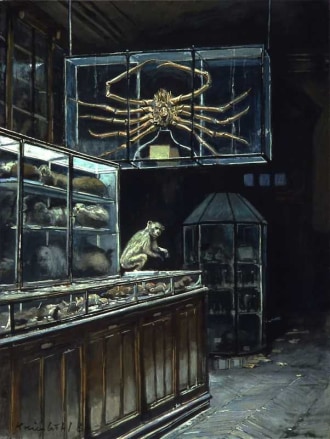
L'Araignée de mer, 1984
vinyl sur papier marouflé sur panneau/vinyl on paper mounted on board
78 x 56 cm
En 1981, Jürg Kreienbühl accepta l’invitation d’un ami peintre de visiter la Galerie de Zoologie du Jardin des Plantes. Il avait déjà exécuté un ensemble de peintures dans la Galerie d’Anatomie comparée une dizaine d’années plus tôt. C’était, depuis 1965, un lieu fermé au public à cause de son état de délabrement, au grand désespoir des chercheurs du Muséum. Voici le récit qu’en fit Kreienbühl, en pénétrant dans la grande galerie :
"Ce que je vis alors dépassait tout ce que j’avais imaginé auparavant. Ce fut un choc immédiat, brutal, balayant d’un seul coup tous les projets des mois à venir. Adieu forêt de Cormeilles, adieu arbres, adieu soleil. La vision de ce hall, immense comme une gare, me laissa cloué sur place. De la pénombre émergeaient un éléphant d’Afrique aux oreilles dressées, un groupe de girafes aux cous gracilement courbés et de gigantesques squelettes de baleine. Dans une légère brume bleutée on devinait des troupeaux de zèbres, de buffles et de fauves à l’affût. L’émotion me submergeait, se changea en frisson et en sueur. Mon cœur battait plus vite, mes oreilles bourdonnaient et je me souvenais des mots de Courbet : "Je suis ému".
Kreienbühl passa trois années dans cette arche de Noé échouée. Grâce à la sympathie des gardiens et des scientifiques qui lui confièrent une clé des lieux, il put peindre de l’aube au crépuscule et contourner l’obstacle majeure du manque de lumière. En disposant ses tableaux en cours aux quatre coins du Muséum et en suivant avec attention les mouvements du soleil, il réussit à capter les moments fugitifs où la lumière touchait tel ou tel recoin du "Louvre des Animaux".
En 1984, la décision fut prise de déménager les collections dans un souterrain, baptisé "Zoothèque", mettant un terme aux travaux de Kreienbühl. Il peignit en tout une soixantaine de tableaux et réalisa plus d’une vingtaine de lithographies. En mai 1985, le Muséum d’Histoire Naturelle de Paris organisa un exposition de ces œuvres, intitulée "Hommage à la galerie de Zoologie".
Après sa peinture des bidonvilles et d’une ancienne usine de saints d’églises, c’est un autre monde perdu dont Kreienbühl se veut le témoin. Toute son œuvre porte la trace des profonds bouleversements socio-économiques et écologiques de la seconde moitié du 20ème siècle. La série de la Galerie de Zoologie résume et peut-être dépasse tous les grands sujets du peintre: "La vie me semblait être le jeu d’un esprit terriblement pervers qui s’amusait à créer, à détruire, à recréer ce que les scientifiques appellent Evolution ; cette évolution, cette pyramide dont le dernier bloc couronnant l’édifice fut sa construction la plus monstrueuse : l’homo sapiens".
In 1981, Jürg Kreienbühl was invited by a painter friend of his to visit the Great Gallery of Evolution (former gallery of Zoology) in Paris. He already realized a series of paintings in the Gallery of Paleontology and Comparative Anatomy ten years ago. Since 1965, it was closed to the public because of disrepair reasons, to the great despair of researchers from the Museum. Here is the story made by Kreienbühl when he entered into the great gallery:
“What I saw then exceeded all that I had imagined. It was an immediate and violent shock which suddenly swept away all the forthcoming projects. Goodbye forest of Cormeilles, goodbye trees, goodbye sun. The vision of the hall, huge like a railway station, left me stuck. From the darkness appeared an African elephant with erect ears, a group of giraffes with slender necks curved and some gigantic whale skeletons. In a slight bluish mist, one could guess herds of zebras, buffalos and wild beasts, on the lookout. Emotion swept over me and turned into shivers and sweat. My heart was beating faster, my ears were buzzing and I remembered these words by Courbet: 'I am touched'.
Kreienbühl spent three years in this grounded Noah’s ark. Thanks to the liking of watchmen and scientists who gave him the keys of the museum, he could paint from dawn to dusk and get round the major obstacle of the lack of light. By placing his paintings in different spots of the Museum and by carefully following the movements of the sun, he succeeded in catching the fugitive moments when light touched some spots or other of the “Louvre of animals”.
In 1984, it was decided to move the collections to an underground place, called “Zootheque”. It put an end to Kreienbühl’s work. He realized about 60 paintings and more than 20 prints. In May 1985, the National Museum of Natural History organized an exhibition of these artworks, entitled “Tribute to the gallery of Zoology”.
After having painted shantytowns and a former factory of Church Saints, Kreienbühl bears witness to another lost world. His whole work shows the deep socioeconomic and ecological changes of the second half of the 20th century. The series of the Museum summarizes and maybe goes over all his great subjects: “Life seemed to me the game of a terribly perverse spirit who had fun in creating, destroying and recreating what scientists called Evolution; this evolution, this pyramid whose last block crowning the structure was his most monstrous creation : the homo sapiens”.